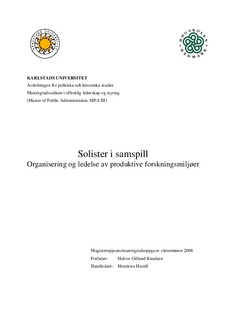| dc.description.abstract | The structural environment for higher education institutions has changed dramatically over the last decades. Mass higher education, a stronger focus on financial and economical matters, and a pressure for more scientific production from the political leadership and society has given the institutions new challenges to deal with. New tasks need competences to deal with them. This has led to a questioning of the traditional model for leading higher education institutions. This model has over the years remained somewhat unchanged, and has been dominated by norms of elected leadership, collegiality, democratic values, and a substantial autonomy for the researchers. This paper aims to shed light on researchers’ perceptions and views on how their own research environment in their own department is led and organized. The task is dealt with by depth interviewing professors in productive research environments in the departments, two at The University of Oslo, and one at The Oslo University College, organized as a case study. The theoretical framework consists of New Public Management theory, institutional theory, and a theoretical model for university organizing by McNay. The findings show that the traditional way of organizing universities persists in these research environments, for the larger part as in the ideal model The Collegium. The researchers value their autonomy high, they look upon the department leaders as distant to the research area, and they view the democratic and collegial mechanisms in the department’s internal life as necessary and valuable. But the organization and leadership of the research environments also have clear elements related to both New Public Management theory and institutional theory, such as an emphasis on the use of several statistical measures on research productivity. These statistics are of bibliographical nature. The use of these measures includes elements of perfor-mance indicators and bench marking systems. These elements are features connected to The Corporation and The Enterprise. Further, the findings show that researchers’ autonomy and relations to the international scientific environment are imperative to researchers in the study. | en |
